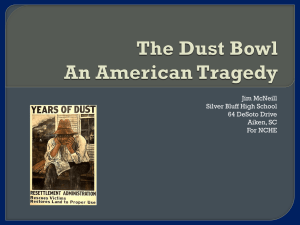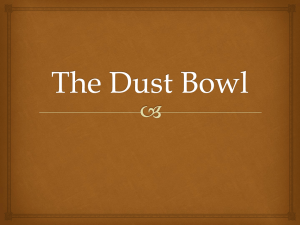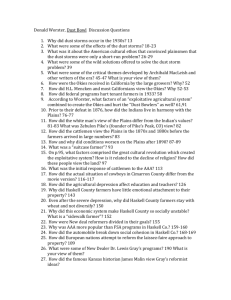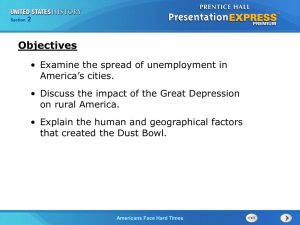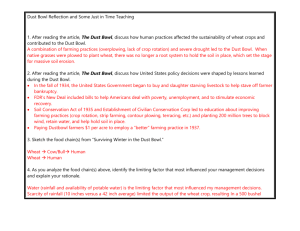File - Mr Khan`s Blog
advertisement
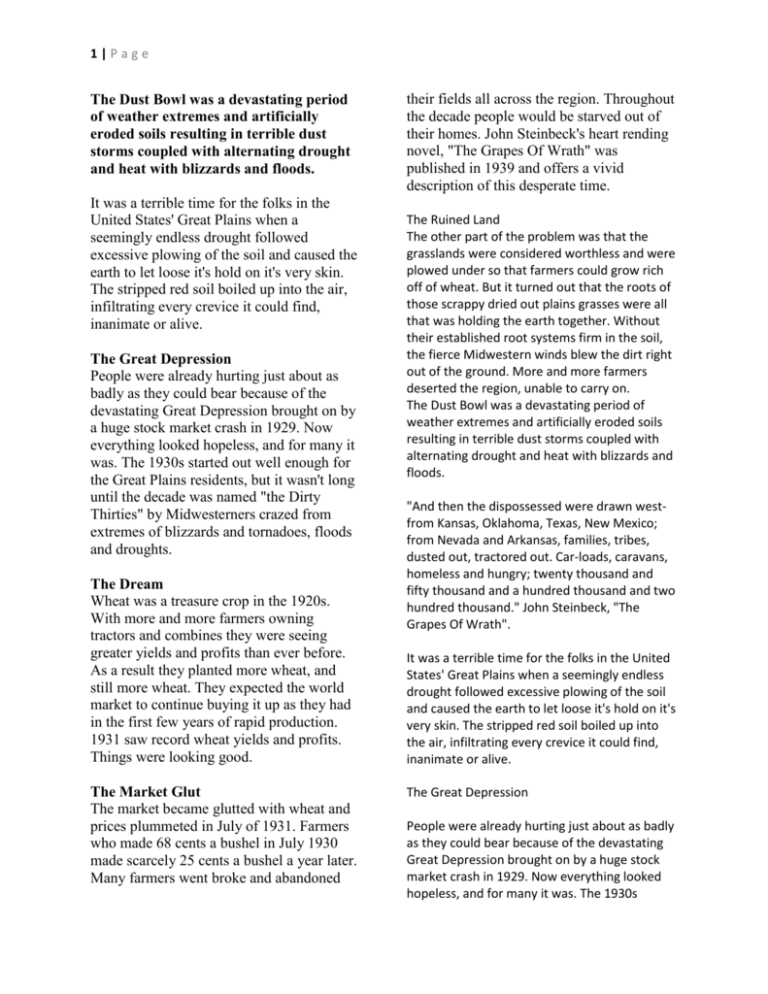
1|Page The Dust Bowl was a devastating period of weather extremes and artificially eroded soils resulting in terrible dust storms coupled with alternating drought and heat with blizzards and floods. It was a terrible time for the folks in the United States' Great Plains when a seemingly endless drought followed excessive plowing of the soil and caused the earth to let loose it's hold on it's very skin. The stripped red soil boiled up into the air, infiltrating every crevice it could find, inanimate or alive. The Great Depression People were already hurting just about as badly as they could bear because of the devastating Great Depression brought on by a huge stock market crash in 1929. Now everything looked hopeless, and for many it was. The 1930s started out well enough for the Great Plains residents, but it wasn't long until the decade was named "the Dirty Thirties" by Midwesterners crazed from extremes of blizzards and tornadoes, floods and droughts. The Dream Wheat was a treasure crop in the 1920s. With more and more farmers owning tractors and combines they were seeing greater yields and profits than ever before. As a result they planted more wheat, and still more wheat. They expected the world market to continue buying it up as they had in the first few years of rapid production. 1931 saw record wheat yields and profits. Things were looking good. The Market Glut The market became glutted with wheat and prices plummeted in July of 1931. Farmers who made 68 cents a bushel in July 1930 made scarcely 25 cents a bushel a year later. Many farmers went broke and abandoned their fields all across the region. Throughout the decade people would be starved out of their homes. John Steinbeck's heart rending novel, "The Grapes Of Wrath" was published in 1939 and offers a vivid description of this desperate time. The Ruined Land The other part of the problem was that the grasslands were considered worthless and were plowed under so that farmers could grow rich off of wheat. But it turned out that the roots of those scrappy dried out plains grasses were all that was holding the earth together. Without their established root systems firm in the soil, the fierce Midwestern winds blew the dirt right out of the ground. More and more farmers deserted the region, unable to carry on. The Dust Bowl was a devastating period of weather extremes and artificially eroded soils resulting in terrible dust storms coupled with alternating drought and heat with blizzards and floods. "And then the dispossessed were drawn westfrom Kansas, Oklahoma, Texas, New Mexico; from Nevada and Arkansas, families, tribes, dusted out, tractored out. Car-loads, caravans, homeless and hungry; twenty thousand and fifty thousand and a hundred thousand and two hundred thousand." John Steinbeck, "The Grapes Of Wrath". It was a terrible time for the folks in the United States' Great Plains when a seemingly endless drought followed excessive plowing of the soil and caused the earth to let loose it's hold on it's very skin. The stripped red soil boiled up into the air, infiltrating every crevice it could find, inanimate or alive. The Great Depression People were already hurting just about as badly as they could bear because of the devastating Great Depression brought on by a huge stock market crash in 1929. Now everything looked hopeless, and for many it was. The 1930s 2|Page started out well enough for the Great Plains residents, but it wasn't long until the decade was named "the Dirty Thirties" by Midwesterners crazed from extremes of blizzards and tornadoes, floods and droughts. up and dumped tons of water on the plains, washing people out of their homesteads. As soon as it got through raining, the dirt blew in, ruining buildings and granaries. When all that damage was done, the blizzards tore down from the north, freezing property, bodies and spirits. The Dream Dust Storms Wheat was a treasure crop in the 1920s. With more and more farmers owning tractors and combines they were seeing greater yields and profits than ever before. As a result they planted more wheat, and still more wheat. They expected the world market to continue buying it up as they had in the first few years of rapid production. 1931 saw record wheat yields and profits. Things were looking good. The Market Glut The market became glutted with wheat and prices plummeted in July of 1931. Farmers who made 68 cents a bushel in July 1930 made scarcely 25 cents a bushel a year later. Many farmers went broke and abandoned their fields all across the region. Throughout the decade people would be starved out of their homes. John Steinbeck's heart rending novel, "The Grapes Of Wrath" was published in 1939 and offers a vivid description of this desperate time. The Ruined Land The other part of the problem was that the grasslands were considered worthless and were plowed under so that farmers could grow rich off of wheat. But it turned out that the roots of those scrappy dried out plains grasses were all that was holding the earth together. Without their established root systems firm in the soil, the fierce Midwestern winds blew the dirt right out of the ground. More and more farmers deserted the region, unable to carry on. The Weather As fate would have it, the weather turned crazy on the farmers that remained. The skies opened Each summer in the early 1930s brought more drought to the region. The heartless winds would fling dirt into drifts several feet high against anything that stood in its path. The insides of houses were nearly as full of dirt as the outsides. Opening the windows to let in air to relieve the oppressive heat invited more dirt than already managed to creep in on its own through any unguarded crevice. People crammed every cranny with scraps of cloth and paper, trying, and failing, to keep out the relentless dirt. They tied dampened bandanas over their mouths and noses and wore goggles if they had to go out of doors. They flapped wet gunny sacks through the air indoors to try to settle the dirt so that they could breathe. Outdoors fences, tractors and walls were buried and hidden beneath drifts of dirt. Livestock suffered and died. The Crops In 1932 the ground was too rock hard from the drought to anyone plant their crops until September. Then came an early frost. The resultant crops were still spindly and small by the time the hard spring freezes came about. 22 days of dirt storms devastated much of that sorry yield. 1933 started with a devastating dirt storm which did in most of the remaining wheat, such as it was. In early February the temperature plunged 74 degrees in just 18 hours in Boise City, Oklahoma. Temperatures stayed below freezing for a few days and broke just in time for yet another dirt storm. Records show 139 days of dust and drought in 1933. 3|Page Tenacity Aftermath A tenacious core of Plains farmers held on and farmed the way their fathers had farmed a generation earlier when these were frontier lands. When the wheat failed, they harvested thistle or soap weed to feed the livestock, and sometimes themselves. It was desperately hard work with no reward beyond knowing they'd done a hard job. Finally toward the end of the thirties, the unprecedented weather extremes and tornados subsided. The area remains harsh but those years of the 1930s were excessive. In 1934 the Dust Bowl got the notice of the rest of the country when a dust storm blew all the way from Texas, Oklahoma and Kansas to Washington DC and New York. There were fewer tornadoes that year than the year before, but now they got record setting ladders of heat that killed hundreds of people in Oklahoma, Kansas, Texas and Colorado. Black Sunday In 1935, on a Sunday that started out fine and glorious, there came a frantic fleeing of birds who could not out fly a dense, dark cloud of dirt that soon overwhelmed the landscape. This, the worst storm yet, earned that day the name "Black Sunday". By now all those who could not take the pressure had either moved far away from this heartbreaking land, or died in it. On this bleak Sunday, many of the people who had managed to survive so far believed the end of the world was at hand. For hours they were trapped indoors unable to see a step ahead through the dirt outdoors. Earthquake On a lovely June day in 1936 an earthquake burst through the hard Oklahoma soil and tore it open from Kenton to Perryton and from Liberal to Stratford. Summer temperatures reached 120 degrees Fahrenheit. The heat wave finally broke that year, but 1937 brought more dirt storms, and 1938 introduced the term "snuster", meaning a blizzard of snow mixed with dirt. Snow and dust. In the years following the Dust Bowl, people set about learning how to conserve and prevent the devastation caused by the loosened soil. Farmers now are taught how to rotate crops and plant soil protecting plants to save the land from another devastation like the Dust Bowl. Subsequent droughts in the region have not produced the devastation of the Dirty Thirties. But a lesson once learned is a lesson best remembered.

